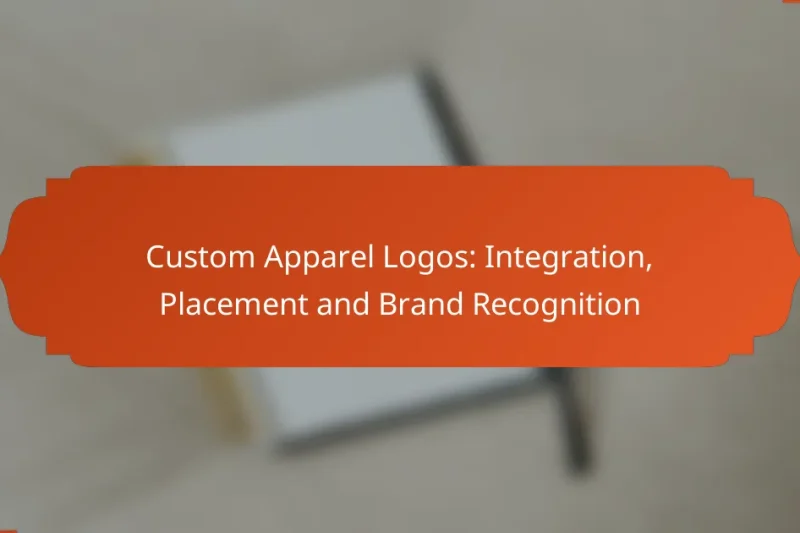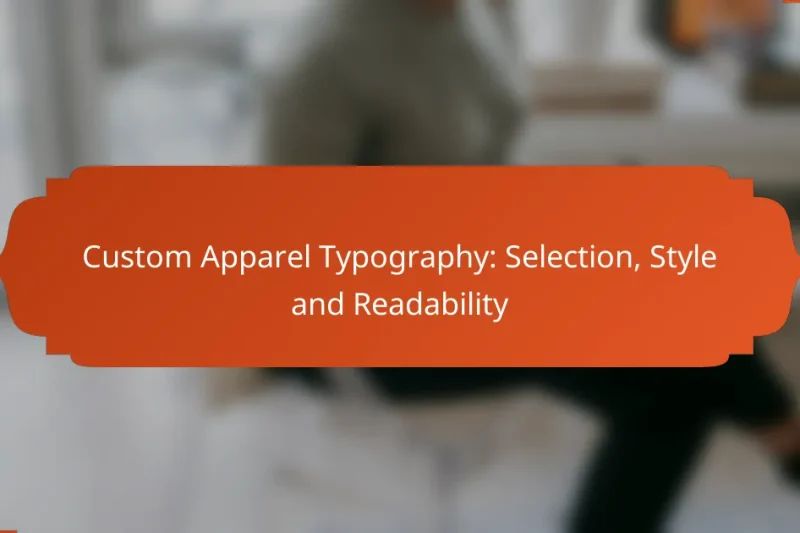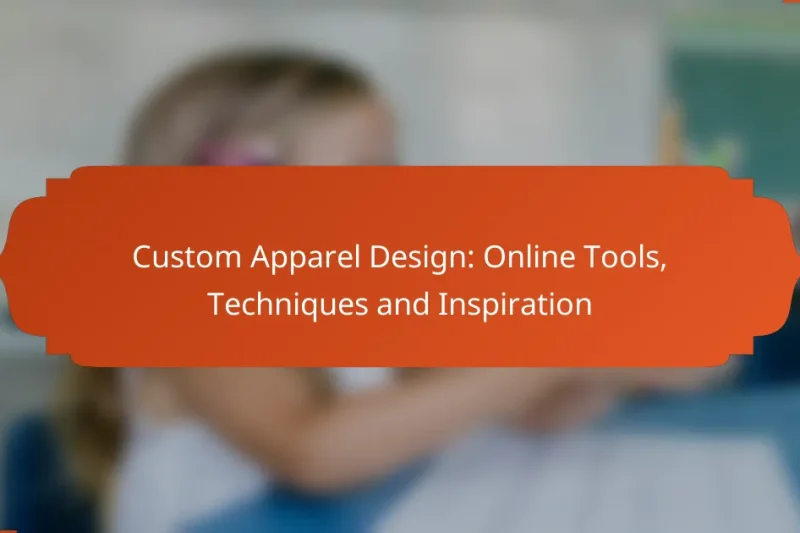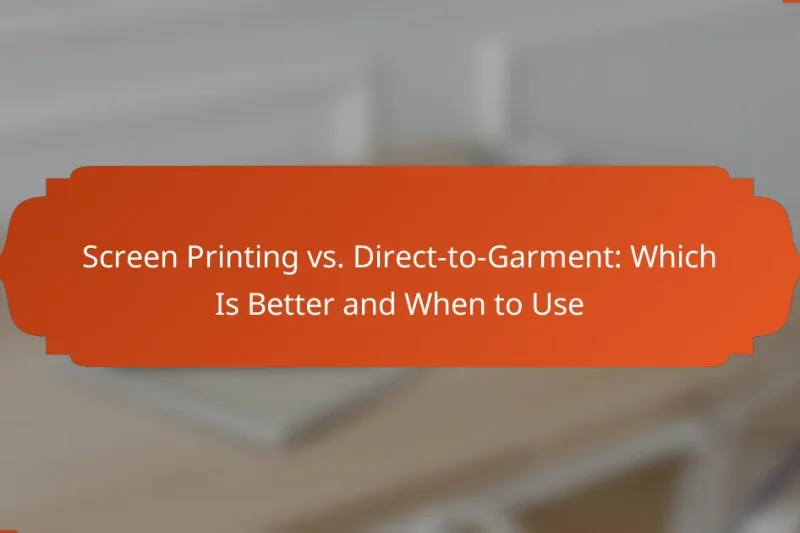Integrating custom apparel logos involves careful consideration of application methods, placement, and alignment with brand identity. … Custom Apparel Logos: Integration, Placement and Brand RecognitionRead more
Design Options for Custom Apparel
When it comes to custom apparel, selecting the right design option is crucial for achieving the desired look and feel. Various techniques such as screen printing, embroidery, and direct-to-garment printing each offer distinct advantages that can influence both aesthetics and cost. Additionally, the choice of fabric plays a significant role in ensuring comfort and durability, making it essential to consider the intended use and maintenance needs. With the right combination of design methods and materials, custom apparel can truly reflect personal style and brand identity.
Custom Apparel Typography: Selection, Style and Readability
When selecting custom apparel typography for e-commerce, it’s essential to consider your target audience and brand … Custom Apparel Typography: Selection, Style and ReadabilityRead more
Custom Apparel Design Placement: Strategies, Visibility and Impact
Custom apparel design placement is crucial for maximizing visibility and engagement with target audiences. By implementing … Custom Apparel Design Placement: Strategies, Visibility and ImpactRead more
Custom Apparel Color Choices: Impact, Psychology and Brand Identity
Color choices in custom apparel are pivotal in shaping customer perception and emotional responses, directly impacting … Custom Apparel Color Choices: Impact, Psychology and Brand IdentityRead more
Custom Apparel for Events: Design, Purpose and Audience Engagement
Custom apparel for events plays a vital role in creating a unique identity that resonates with … Custom Apparel for Events: Design, Purpose and Audience EngagementRead more
Custom Apparel Design: Online Tools, Techniques and Inspiration
Custom apparel design has become more accessible than ever with a variety of online tools that … Custom Apparel Design: Online Tools, Techniques and InspirationRead more
Screen Printing vs. Direct-to-Garment: Which Is Better and When to Use
When deciding between screen printing and direct-to-garment (DTG) printing, it’s essential to consider your specific needs … Screen Printing vs. Direct-to-Garment: Which Is Better and When to UseRead more
What are the best design options for custom apparel in the USA?
The best design options for custom apparel in the USA include screen printing, embroidery, direct-to-garment printing, heat transfer vinyl, and all-over sublimation. Each method offers unique advantages and considerations that can impact the final product’s look, feel, and cost.
Screen printing
Screen printing is a popular method for producing vibrant designs on apparel. It involves creating a stencil (or screen) and using it to apply layers of ink onto the fabric. This technique is best suited for larger orders, as the setup costs can be high, but it offers excellent durability and color richness.
When considering screen printing, think about the number of colors in your design. More colors can increase costs, so designs with fewer colors are often more economical. Additionally, this method works well on cotton and blends, making it versatile for various apparel types.
Embroidery
Embroidery adds a textured, professional look to custom apparel by stitching designs directly onto the fabric. This method is ideal for logos and text, particularly on items like hats and polo shirts. Embroidery is known for its durability and upscale appearance.
Keep in mind that embroidery can be more expensive than other methods, especially for intricate designs or small text. It’s best suited for smaller runs or items where a high-quality finish is desired. Consider the fabric type, as thicker materials work best for embroidery.
Direct-to-garment printing
Direct-to-garment (DTG) printing allows for high-resolution, full-color designs to be printed directly onto the fabric. This method is ideal for intricate designs and smaller quantities, making it a great option for custom apparel with detailed artwork.
While DTG offers flexibility and quick turnaround times, it may not be as durable as screen printing or embroidery. It’s best to use this method on 100% cotton garments for optimal results. Be aware that the cost per item can be higher for larger orders compared to bulk screen printing.
Heat transfer vinyl
Heat transfer vinyl (HTV) involves cutting designs from vinyl sheets and applying them to fabric using heat and pressure. This method is great for small runs and allows for vibrant colors and intricate designs. HTV is particularly popular for custom t-shirts and sportswear.
One advantage of HTV is its quick application process, making it suitable for on-demand printing. However, it may not be as durable as screen printing for long-term wear. Ensure the fabric is compatible with heat application to avoid damage during the process.
All-over sublimation
All-over sublimation is a dye-sublimation technique that allows for designs to cover the entire garment. This method is perfect for creating unique, eye-catching apparel, especially on polyester fabrics. The dye becomes part of the fabric, resulting in vibrant colors that won’t fade or crack.
While sublimation offers excellent quality, it is limited to light-colored, synthetic fabrics. The setup costs can be higher, making it less economical for small orders. This method is ideal for sportswear, fashion apparel, and promotional items where standout designs are essential.
How to choose the right fabric for custom apparel?
Choosing the right fabric for custom apparel is essential for comfort, durability, and overall appearance. Consider factors like the intended use, climate, and maintenance requirements to make an informed decision.
Cotton for comfort
Cotton is a popular choice for custom apparel due to its softness and breathability. It is ideal for casual wear and is often used in t-shirts, hoodies, and summer clothing.
When selecting cotton, look for options like combed or ring-spun cotton for a smoother finish. Keep in mind that while cotton is comfortable, it may shrink or wrinkle easily, so consider pre-shrunk varieties for better longevity.
Polyester for durability
Polyester is known for its strength and resistance to shrinking and stretching, making it a great option for activewear and uniforms. It dries quickly and retains its shape well, which is beneficial for items that undergo frequent washing.
When choosing polyester, consider moisture-wicking properties if the apparel will be used for sports or outdoor activities. Blends with cotton can also enhance comfort while maintaining durability.
Blends for versatility
Fabric blends, such as cotton-polyester mixes, offer a balance of comfort and durability. These blends can provide the softness of cotton while benefiting from the strength and wrinkle resistance of polyester.
When selecting blends, check the fabric ratio to ensure it meets your needs. A common blend is 60% cotton and 40% polyester, which combines breathability with durability, making it suitable for a variety of applications from casual wear to work uniforms.
What customization techniques are available?
Custom apparel can be tailored using various techniques that enhance design and personalization. Key methods include graphic design integration, color matching services, and personalized text options, each offering unique benefits and considerations.
Graphic design integration
Graphic design integration involves incorporating custom artwork, logos, or images into apparel. This technique allows brands or individuals to showcase their identity through visuals, making garments stand out. It is essential to ensure that the resolution of the graphics is high enough for printing, typically at least 300 DPI.
When choosing graphic design, consider the placement and size of the artwork. Common locations include the front, back, or sleeves of the apparel. Additionally, be aware of the printing methods available, such as screen printing or direct-to-garment (DTG), as they can affect the final look and durability of the design.
Color matching services
Color matching services help ensure that the colors used in custom apparel align with specific brand guidelines or personal preferences. This process often involves using color swatches or digital tools to achieve the desired hue. It is crucial to communicate clearly about the color expectations to avoid discrepancies.
Many printing companies provide Pantone color matching, which is a standardized color reproduction system. This can be particularly useful for businesses looking to maintain brand consistency across various products. Always request a sample before final production to confirm that the colors appear as intended on the fabric.
Personalized text options
Personalized text options allow individuals to add names, slogans, or messages to their apparel. This customization can be done through embroidery, heat transfer, or printing, depending on the desired effect and durability. Consider the font style and size, as they can significantly impact readability and overall aesthetics.
When selecting personalized text, keep in mind the character limit and placement. For example, a name on the back of a jersey may require a different font size compared to a slogan on the front. Always proofread the text before finalizing the design to avoid errors that could lead to dissatisfaction.
How to ensure quality in custom apparel design?
To ensure quality in custom apparel design, focus on a thorough review process that includes sample approvals, material assessments, and adherence to print resolution standards. These steps help maintain high standards and meet customer expectations.
Sample approval process
The sample approval process is critical for verifying that the final product aligns with design specifications. Start by requesting a prototype from your manufacturer, which should closely match the intended design in terms of color, fit, and overall quality.
Once you receive the sample, conduct a detailed review, checking for any discrepancies or defects. It’s advisable to involve stakeholders in this review to gather diverse feedback before giving final approval.
Material quality checks
Material quality checks ensure that the fabrics used in custom apparel meet durability and comfort standards. Request swatches of the materials to evaluate their texture, weight, and colorfastness before production begins.
Consider using materials that are certified for safety and sustainability, especially if the apparel is intended for children or sensitive skin. Look for certifications like OEKO-TEX or GOTS to ensure compliance with quality standards.
Print resolution standards
Print resolution standards are essential for achieving clear and vibrant designs on custom apparel. Aim for a minimum resolution of 300 DPI (dots per inch) for images to ensure that prints are sharp and detailed.
Before finalizing designs, verify that the artwork files are in the correct format and resolution. Common formats include PNG and vector files like AI or EPS, which maintain quality during scaling. Always review proofs to confirm that colors and details appear as expected before mass production.
What are the pricing factors for custom apparel?
The pricing of custom apparel is influenced by several key factors, including order quantity, design complexity, and fabric choice. Understanding these elements can help you make informed decisions to manage costs effectively.
Quantity discounts
Quantity discounts are a significant factor in the pricing of custom apparel. Generally, the more units you order, the lower the cost per item. For instance, ordering a small batch of 10 shirts may cost significantly more per shirt than ordering 100 shirts, where bulk pricing can reduce costs by 20-50%.
When planning your order, consider how many items you realistically need. If you can increase your order size, you may benefit from these discounts, making it more economical in the long run.
Design complexity
The complexity of your design directly impacts the cost of custom apparel. Simple designs, like basic logos or text, are usually less expensive to produce compared to intricate graphics or multi-color prints. For example, a single-color logo might add only a few dollars to the cost, while a detailed, multi-color design could increase the price by a significant margin.
To manage costs, simplify your design where possible. Consider using fewer colors or simpler graphics, which can help keep your project within budget while still achieving a professional look.
Fabric choice impacts
The choice of fabric plays a crucial role in the overall cost of custom apparel. Different materials come with varying price points; for instance, cotton is generally more affordable than specialized fabrics like moisture-wicking polyester or organic cotton. Depending on your needs, fabric costs can vary by 10-30% or more.
When selecting fabric, balance quality with budget. If durability and comfort are priorities, investing in higher-quality materials may be worthwhile. However, for one-time events or promotional items, opting for more economical fabrics can help reduce expenses.
How to select a reliable custom apparel vendor?
Selecting a reliable custom apparel vendor involves evaluating their quality, service, and pricing. Look for vendors with a solid reputation, positive reviews, and a portfolio that showcases their work.
Check Reviews and References
Start by researching customer reviews on platforms like Google, Yelp, or specialized apparel forums. Pay attention to feedback regarding product quality, delivery times, and customer service. Additionally, ask the vendor for references from previous clients to gain insights into their reliability.
Evaluate Product Quality
Assess the quality of materials and printing techniques used by the vendor. Request samples to examine fabric feel, durability, and print clarity. A good vendor should offer a range of materials and customization options to suit your needs.
Compare Pricing and Services
Gather quotes from multiple vendors to compare pricing structures. Be cautious of prices that seem too low, as they may indicate lower quality. Look for vendors that provide clear pricing, including setup fees, shipping costs, and any additional charges for custom designs.
Understand Turnaround Times
Inquire about the vendor’s production and shipping timelines. Reliable vendors should provide clear estimates for how long it will take to fulfill your order. Consider your deadlines and ensure the vendor can meet them without compromising quality.
Assess Customer Support
Effective communication is crucial when working with a custom apparel vendor. Evaluate their responsiveness during your initial inquiries. A vendor that is attentive and provides clear answers is likely to offer better support throughout the production process.






